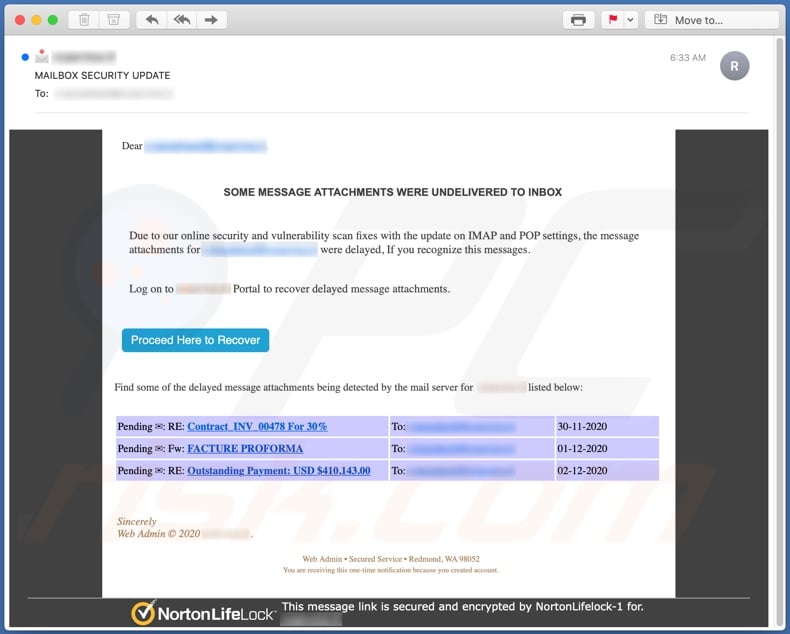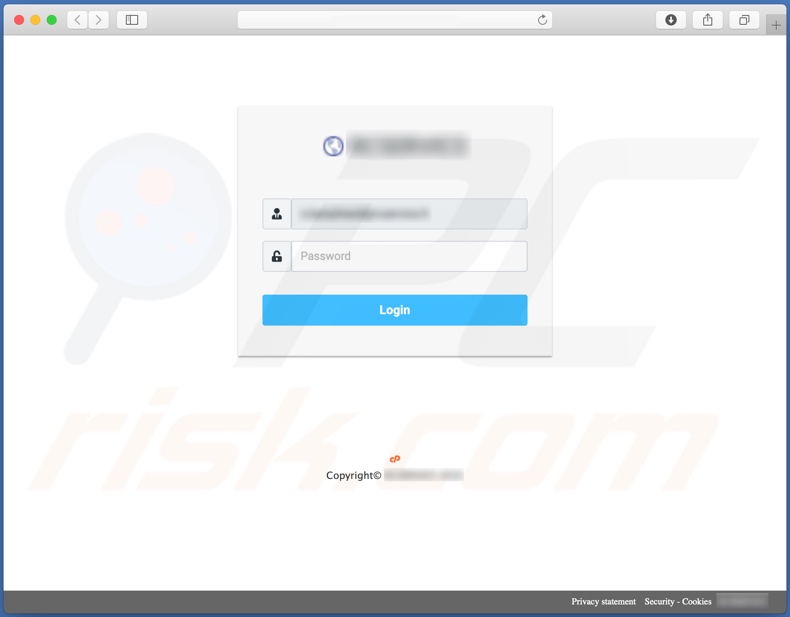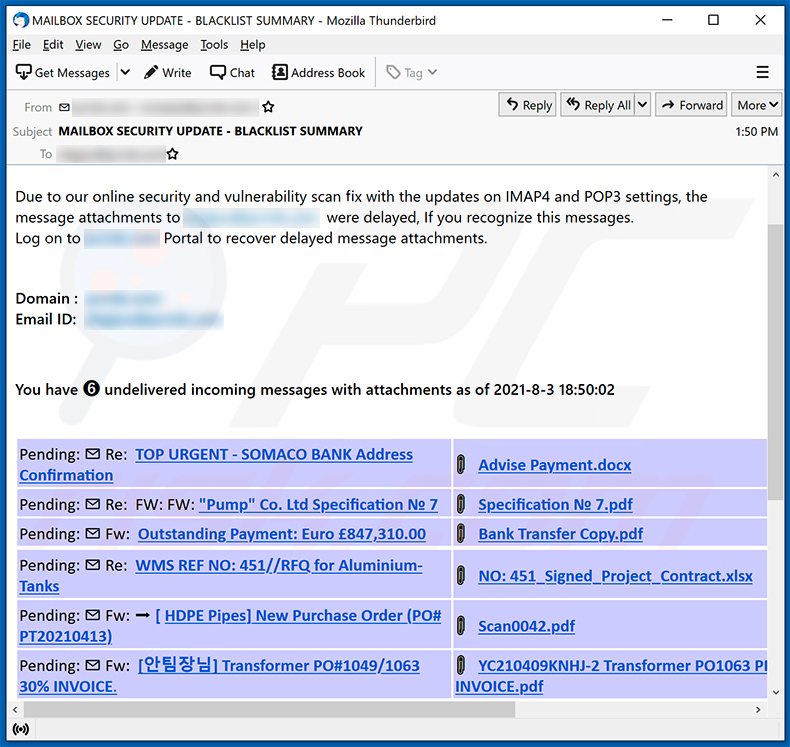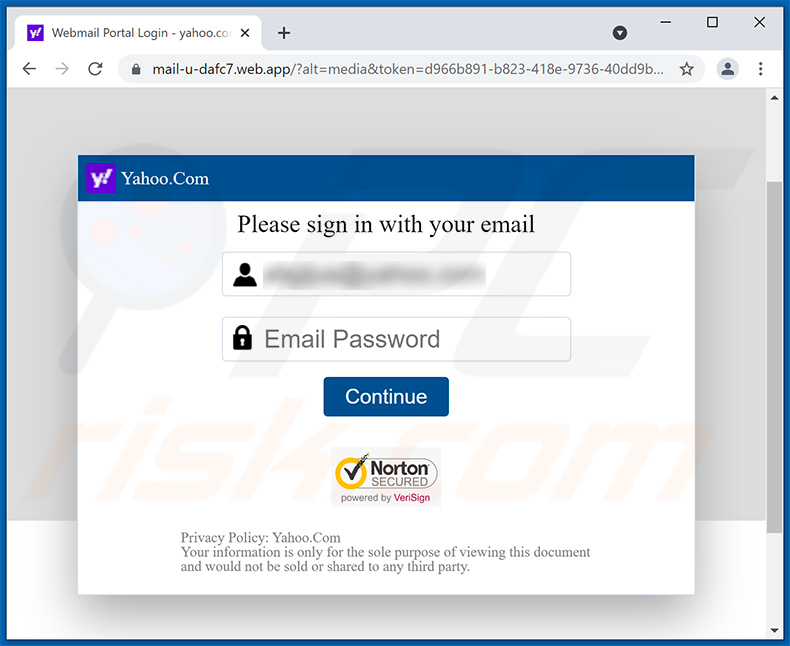Do not trust the "Message attachments were delayed" scam emails
Phishing/ScamAlso Known As: Message Attachments Were Delayed spam
Get free scan and check if your device is infected.
Remove it nowTo use full-featured product, you have to purchase a license for Combo Cleaner. Seven days free trial available. Combo Cleaner is owned and operated by RCS LT, the parent company of PCRisk.com.
What is the "Message attachments were delayed" email?
"Message attachments were delayed" refers to a spam email campaign. The term "spam campaign" refers to a mass-scale operation, during which thousands of scam emails are sent. These deceptive messages claim that several email attachments have been delayed and were not delivered to the inbox.
To access the attached files, recipients are instructed to click a button, which redirects to a phishing website. This site is presented as a log-in page for the recipient's mail account. Note that the "Message attachments were delayed" promoted web page records information (i.e. passwords) entered into it.

The "Message attachments were delayed" scam messages (subject/title "MAILBOX SECURITY UPDATE" might vary) informs recipients that some email attachments were not delivered to their inboxes. Allegedly, the nonexistent attachments failed to arrive, due to security/vulnerability scans and updates undertaken by recipients' mail service providers, which changed certain settings to the email accounts' settings.
The undelivered attached files are listed as: "RE: Contract_INV_00478 For 30%", "Fw: FACTURE PROFORMA" and "RE: Outstanding Payment: USD $410,143.00". To access the attachments, recipients are to log-in to their email portal by clicking the "Proceed Here to Recover" button. This link redirects to a phishing website that is disguised as the log-in page to recipients' email accounts. By trying to sign-in through this web page, recipients will inadvertently expose their mail account credentials (i.e. passwords) to the scammers behind "Message attachments were delayed" emails.
As mentioned, these messages are scams and none of the information provided by them is genuine. Scammers are particularly interested in email accounts as they are often connected to others (e.g. social networking/media, messaging platform, file storage and transferring, e-commerce, digital wallet, banking and various other accounts). Therefore, through hijacked email accounts, scammers can gain access to users' other accounts. To summarize, by trusting the "Message attachments were delayed" scam messages, users might have their email accounts stolen (and any others associated with them), and experience serious privacy issues, financial loss and even identity theft.
If attempts to sign-in through the phishing site have already been made, you are strongly advised to change the passwords and contact official support of any potentially compromised accounts.
| Name | Message Attachments Were Delayed Email Scam. |
| Threat Type | Phishing, Scam, Social Engineering, Fraud. |
| Fake Claim | Scam emails claim several attachments did not reach the inbox. |
| Symptoms | Unauthorized online purchases, changed online account passwords, identity theft, illegal access of the computer. |
| Distribution methods | Deceptive emails, rogue online pop-up ads, search engine poisoning techniques, misspelled domains. |
| Damage | Loss of sensitive private information, monetary loss, identity theft. |
| Malware Removal (Windows) |
To eliminate possible malware infections, scan your computer with legitimate antivirus software. Our security researchers recommend using Combo Cleaner. Download Combo CleanerTo use full-featured product, you have to purchase a license for Combo Cleaner. 7 days free trial available. Combo Cleaner is owned and operated by RCS LT, the parent company of PCRisk.com. |
"National UK Lottery", "Zoom Email Scam", "Deactivating All Inactive Accounts" and "Google Forms Email Scam" are some examples of other phishing spam campaigns. Deceptive emails are usually presented as "official", "urgent", "important", "priority" and similar.
Phishing scams do not target account log-in credentials exclusively, they can also be designed to gather various sensitive/private information. Spam campaigns are also used for other scams and to spread malware (e.g. Trojans, ransomware, etc.). Due to the relative prevalence of this mail, it is important to exercise caution with incoming emails.
How do spam campaigns infect computers?
Systems are infected via malicious files distributed through spam campaigns. These files can be attached and/or linked inside the emails.
Infectious files can be in various formats (e.g. Microsoft Office and PDF documents, archive and executable files, JavaScript, etc.). When these files are executed, run or otherwise opened, the infection process (i.e. malware download/installation) is triggered. For example, Microsoft Office documents (e.g. "Invoice_24077.xlsb") cause infections by executing malicious macro commands.
In Microsoft Office versions released prior to 2010, malware download/installation begins when an infectious document is opened, however, newer versions have "Protected View" mode that prevents automatic execution of macros. Instead, users are asked to enable macro commands (i.e., to enable editing/content) and hence infection processes can only be started by manually enabling macros.
How to avoid installation of malware?
To avoid malware spread via spam mail, you are strongly advised against opening suspicious or irrelevant emails, especially those with any attachments or links present within them. Additionally, use Microsoft Office versions released after 2010.
Malicious programs also proliferate through untrusted download channels (e.g. unofficial and free file-hosting sites, Peer-to-Peer sharing networks and other third party downloaders), illegal software activation ("cracking") tools, and fake updaters. Therefore, only download from official/verified sources and activate and update software with tools/functions provided by legitimate developers. To ensure device integrity and user privacy, have a reputable anti-virus/anti-spyware suite installed and kept updated. Furthermore, use these programs to run regular system scans and to remove detected/potential threats.
If you have already opened malicious attachments, we recommend running a scan with Combo Cleaner Antivirus for Windows to automatically eliminate infiltrated malware.
Text presented in the "Message attachments were delayed" email message:
Subject: MAILBOX SECURITY UPDATE
Dear *********,
SOME MESSAGE ATTACHMENTS WERE UNDELIVERED TO INBOX
Due to our online security and vulnerability scan fixes with the update on IMAP and POP settings, the message attachments for ********* were delayed, If you recognize this messages.
Log on to ********* Portal to recover delayed message attachments.
Proceed Here to Recover
Find some of the delayed message attachments being detected by the mail server for ********* listed below:
Pending ✉: RE: Contract_INV_00478 For 30% To: ********* 30-11-2020
Pending ✉: Fw: FACTURE PROFORMA To: ********* 01-12-2020
Pending ✉: RE: Outstanding Payment: USD $410,143.00 To: ********* 02-12-2020
Sincerely
Web Admin © 2020 *********.
Web Admin • Secured Service • Redmond, WA 98052
You are receiving this one-time notification because you created account.
This message link is secured and encrypted by NortonLifelock-1 for.
Screenshot of the phishing website promoted via "Message attachments were delayed" spam campaign:

Another example of "Message Attachments Were Delayed"-themed spam email promoting a phishing site:

Text presented within:
Subject: MAILBOX SECURITY UPDATE - BLACKLIST SUMMARY
Dear ********,
Due to our online security and vulnerability scan fix with the updates on IMAP4 and POP3 settings, the message attachments to ******** were delayed, If you recognize this messages.
Log on to ******** Portal to recover delayed message attachments.Domain : ********
Email ID: ********You have 6 undelivered incoming messages with attachments as of 2021-8-3 18:50:02
Pending: Re: TOP URGENT - SOMACO BANK Address Confirmation Advise Payment.docx 27-07-2021
Pending: Re: FW: FW: "Pump" Co. Ltd Specification No 7 Specification No 7.pdf 28-07-2021
Pending: Fw: Outstanding Payment: Euro £847,310.00 Bank Transfer Copy.pdf 29-07-2021
Pending: Re: WMS REF NO: 451//RFQ for Aluminium-Tanks NO: 451_Signed_Project_Contract.xlsx 30-07-2021
Pending: Fw: [ HDPE Pipes] New Purchase Order (PO# PT20210413) Scan0042.pdf 02-08-2021
Pending: Fw: [안팀장님] Transformer PO#1049/1063 30% INVOICE. YC210409KNHJ-2 Transformer PO1063 PROFORMA INVOICE.pdf 03-08-2021Proceed to Domain Portal and Recover Now!
Sincerely
Admin WebHost (C) 2021 Secured Service.
******** Web Admin • Redmond, WA 98052
You are receiving this one-time notification because your created account.
Screenshot of the promoted phishing site:

Instant automatic malware removal:
Manual threat removal might be a lengthy and complicated process that requires advanced IT skills. Combo Cleaner is a professional automatic malware removal tool that is recommended to get rid of malware. Download it by clicking the button below:
DOWNLOAD Combo CleanerBy downloading any software listed on this website you agree to our Privacy Policy and Terms of Use. To use full-featured product, you have to purchase a license for Combo Cleaner. 7 days free trial available. Combo Cleaner is owned and operated by RCS LT, the parent company of PCRisk.com.
Quick menu:
- What is Message Attachments Were Delayed spam?
- Types of malicious emails.
- How to spot a malicious email?
- What to do if you fell for an email scam?
Types of malicious emails:
![]() Phishing Emails
Phishing Emails
Most commonly, cybercriminals use deceptive emails to trick Internet users into giving away their sensitive private information, for example, login information for various online services, email accounts, or online banking information.
Such attacks are called phishing. In a phishing attack, cybercriminals usually send an email message with some popular service logo (for example, Microsoft, DHL, Amazon, Netflix), create urgency (wrong shipping address, expired password, etc.), and place a link which they hope their potential victims will click on.
After clicking the link presented in such email message, victims are redirected to a fake website that looks identical or extremely similar to the original one. Victims are then asked to enter their password, credit card details, or some other information that gets stolen by cybercriminals.
![]() Emails with Malicious Attachments
Emails with Malicious Attachments
Another popular attack vector is email spam with malicious attachments that infect users' computers with malware. Malicious attachments usually carry trojans that are capable of stealing passwords, banking information, and other sensitive information.
In such attacks, cybercriminals' main goal is to trick their potential victims into opening an infected email attachment. To achieve this goal, email messages usually talk about recently received invoices, faxes, or voice messages.
If a potential victim falls for the lure and opens the attachment, their computers get infected, and cybercriminals can collect a lot of sensitive information.
While it's a more complicated method to steal personal information (spam filters and antivirus programs usually detect such attempts), if successful, cybercriminals can get a much wider array of data and can collect information for a long period of time.
![]() Sextortion Emails
Sextortion Emails
This is a type of phishing. In this case, users receive an email claiming that a cybercriminal could access the webcam of the potential victim and has a video recording of one's masturbation.
To get rid of the video, victims are asked to pay a ransom (usually using Bitcoin or another cryptocurrency). Nevertheless, all of these claims are false - users who receive such emails should ignore and delete them.
How to spot a malicious email?
While cyber criminals try to make their lure emails look trustworthy, here are some things that you should look for when trying to spot a phishing email:
- Check the sender's ("from") email address: Hover your mouse over the "from" address and check if it's legitimate. For example, if you received an email from Microsoft, be sure to check if the email address is @microsoft.com and not something suspicious like @m1crosoft.com, @microsfot.com, @account-security-noreply.com, etc.
- Check for generic greetings: If the greeting in the email is "Dear user", "Dear @youremail.com", "Dear valued customer", this should raise suspiciousness. Most commonly, companies call you by your name. Lack of this information could signal a phishing attempt.
- Check the links in the email: Hover your mouse over the link presented in the email, if the link that appears seems suspicious, don't click it. For example, if you received an email from Microsoft and the link in the email shows that it will go to firebasestorage.googleapis.com/v0... you shouldn't trust it. It's best not to click any links in the emails but to visit the company website that sent you the email in the first place.
- Don't blindly trust email attachments: Most commonly, legitimate companies will ask you to log in to their website and to view any documents there; if you received an email with an attachment, it's a good idea to scan it with an antivirus application. Infected email attachments are a common attack vector used by cybercriminals.
To minimise the risk of opening phishing and malicious emails we recommend using Combo Cleaner Antivirus for Windows.
Example of a spam email:

What to do if you fell for an email scam?
- If you clicked on a link in a phishing email and entered your password - be sure to change your password as soon as possible. Usually, cybercriminals collect stolen credentials and then sell them to other groups that use them for malicious purposes. If you change your password in a timely manner, there's a chance that criminals won't have enough time to do any damage.
- If you entered your credit card information - contact your bank as soon as possible and explain the situation. There's a good chance that you will need to cancel your compromised credit card and get a new one.
- If you see any signs of identity theft - you should immediately contact the Federal Trade Commission. This institution will collect information about your situation and create a personal recovery plan.
- If you opened a malicious attachment - your computer is probably infected, you should scan it with a reputable antivirus application. For this purpose, we recommend using Combo Cleaner Antivirus for Windows.
- Help other Internet users - report phishing emails to Anti-Phishing Working Group, FBI’s Internet Crime Complaint Center, National Fraud Information Center and U.S. Department of Justice.
Share:

Tomas Meskauskas
Expert security researcher, professional malware analyst
I am passionate about computer security and technology. I have an experience of over 10 years working in various companies related to computer technical issue solving and Internet security. I have been working as an author and editor for pcrisk.com since 2010. Follow me on Twitter and LinkedIn to stay informed about the latest online security threats.
PCrisk security portal is brought by a company RCS LT.
Joined forces of security researchers help educate computer users about the latest online security threats. More information about the company RCS LT.
Our malware removal guides are free. However, if you want to support us you can send us a donation.
DonatePCrisk security portal is brought by a company RCS LT.
Joined forces of security researchers help educate computer users about the latest online security threats. More information about the company RCS LT.
Our malware removal guides are free. However, if you want to support us you can send us a donation.
Donate
▼ Show Discussion